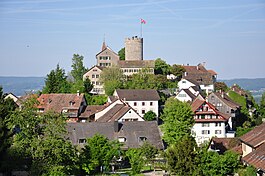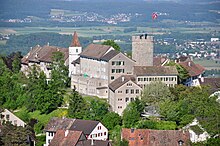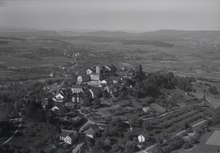Regensberg
Regensberg | |
|---|---|
 | |
| Website | www SFSO statistics |


Regensberg is a
History
Regensberg was founded as a hilltop fortified settlement about 1245 by Baron Lüthold of Regensberg. The fortifications include a 21 m (69 ft) high round tower dating from the 16th or 17th century and a 57 m (187 ft) deep water well. The church, originally dating from the 13th century, was rebuilt in 1506.
During the mid 13th Century relations between the Barons of Regensberg and the city of Zürich became strained. At about this same time, the barons began to argue with the Habsburgs over who would inherit the lands of the now extinct Kyburg family. In 1267 the disputes led to war between the barons and the combined Zürich and Habsburg forces. The barons lost this war, and rapidly declined in power over the following half century. In 1302 they sold Regensberg to the Habsburgs.
The Habsburgs established an Amt Regensberg with a Habsburg appointed
In 1409 the Habsburg duke
In 1540 the upper castle burned down, but the lower gates and the
Following the collapse of the Swiss
Historic attractions include the half-timbered "Rote Rose" house dating from 1540.
Citizens
Eberhard II was born in Regensberg around 1170 and died in
Geography

Regensberg has an area of 2.4 km2 (0.93 sq mi). Of this area, 34.5% is used for agricultural purposes, while 56.7% is forested. The rest of the land, (8.8%) is settled.[4]
Demographics
Regensberg has a population (as of 31 December 2020) of 459.[5] As of 2007[update], 16.3% of the population was made up of foreign nationals. Over the last 10 years the population has decreased at a rate of -1.3%. Most of the population (as of 2000[update]) speaks German (93.0%), with French being second most common ( 1.6%) and English being third ( 1.2%).
In the 2007 election the most popular party was the SVP which received 31.1% of the vote. The next three most popular parties were the FDP (17.9%), the Green Party (14.5%) and the SPS (13.7%).
The age distribution of the population (as of 2000[update]) is children and teenagers (0–19 years old) make up 23.8% of the population, while adults (20–64 years old) make up 65.9% and seniors (over 64 years old) make up 10.3%. In Regensberg about 86.8% of the population (between age 25-64) have completed either non-mandatory upper secondary education or additional higher education (either university or a Fachhochschule).
Regensberg has an unemployment rate of 1.48%. As of 2005[update], there were 18 people employed in the primary economic sector and about 6 businesses involved in this sector. 14 people are employed in the secondary sector and there are 3 businesses in this sector. 121 people are employed in the tertiary sector, with 16 businesses in this sector.[4]
References
- ^ a b "Arealstatistik Standard - Gemeinden nach 4 Hauptbereichen". Federal Statistical Office. Retrieved 13 January 2019.
- ^ "Ständige Wohnbevölkerung nach Staatsangehörigkeitskategorie Geschlecht und Gemeinde; Provisorische Jahresergebnisse; 2018". Federal Statistical Office. 9 April 2019. Retrieved 11 April 2019.
- ^ Regensberg website history. (in German) accessed 4 August 2009
- ^ a b Swiss Federal Statistical Office accessed 04-Aug-2009
- ^ "Ständige und nichtständige Wohnbevölkerung nach institutionellen Gliederungen, Geburtsort und Staatsangehörigkeit". bfs.admin.ch (in German). Swiss Federal Statistical Office - STAT-TAB. 31 December 2020. Retrieved 21 September 2021.
External links
- Official website (in German)
- Commune flag


